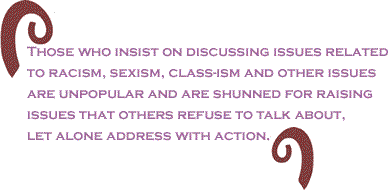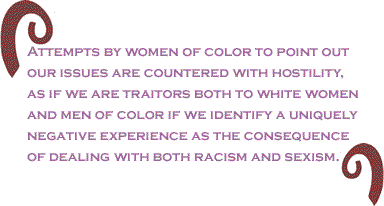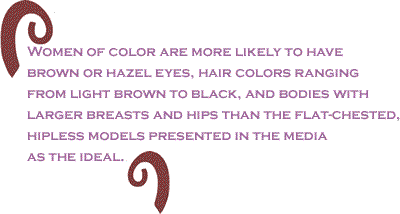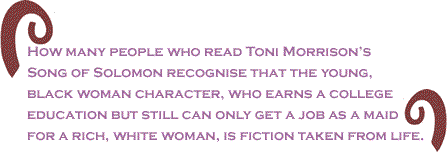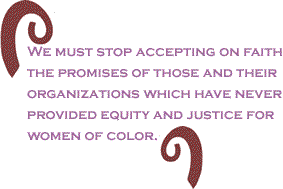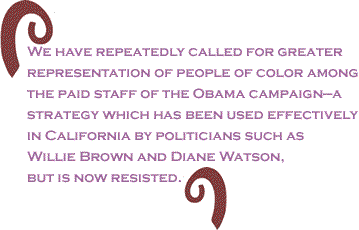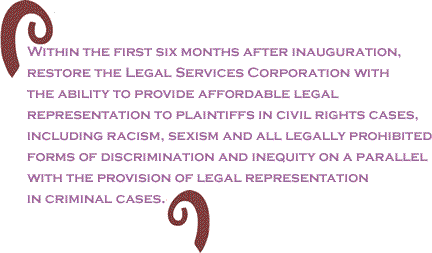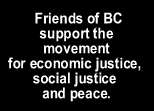
|
|||||||||||||||||||||||

|
|

Custom Search
|
|
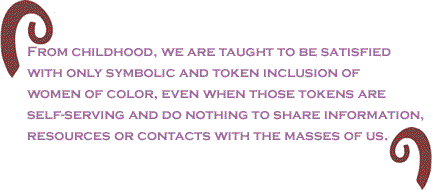 |
|
Twenty-four years ago, as first author, I drafted the initial sections of the collaborative paper, “Moving Mountains, Past, Present and Future: The Role of Women of Color in the American Political System.” Published by the National Institute for Women of Color (NIWC) with a Ford Foundation grant, it was the first of a series of four Brown Papers. I was a board member of NIWC, employed at the time as Affirmative Action Officer, University of Nevada Reno (UNR). I served on the NIWC board for 11 years. I lasted at UNR for 2 years, before moving on to Penn State University as Affirmative Action Officer. Before UNR, I was director of Science Supportive Services at Washington State University. After Penn State, I directed the California State University, Sacramento, Multi-Cultural Center. Each role or position was marked by hard work, routinely 60 to 80 hours a week or more, which yielded many achievements and much more education and experience in every position. Yet, while male subordinates and collaborative colleagues commonly received high praise for carrying out my concepts and directives in programs, strategies and activities of my design and development, there has been an ongoing and persistent reluctance to credit me with the successes of the offices, programs, staff, fund raising, or innovations. Many have taken credit for my work. Most significantly, my experience is not unique. Rather it is a common experience of women of color, not only in educational institutions from K-12 to the university, but in the nonprofit, business, corporate, government and community sectors. The consequences of these circumstances is to minimize and belittle the achievements and contributions of women of color, to demand our perpetual sacrifice to the good of others with no share of benefit to ourselves, to denigrate efforts to improve conditions for ourselves and our sisters of color, to insist that we see the successes of white women and men of color as our own and not to “nitpick” by insisting that we have the same benefits of citizenship and revolutionary change in fact and not simply in symbols. From childhood, we are taught to be satisfied with only symbolic and token inclusion of women of color, even when those tokens are self-serving and do nothing to share information, resources or contacts with the masses of us. In 2008, women of color are still being told to wait even to be mentioned until after the election. We are told not to make waves that might hurt the chances of a White woman or Black man despite their refusal to address us or our issues directly. We are told to have hope of changes for the better with no basis for such hope since we are being told the same things we have heard for more than 200 years.. In some instances we are subjected to hostility and discourtesy simply for mentioning that there is an intersection of racism and sexism which impacts us in unique ways. Worst of all, the injury and deaths resulting from our social, emotional, physical, psychological experiences are ignored as though we do not exist. We are still coping with the Myth of The Superwoman described by Michele Wallace 34 years ago. We are every bit as invisible as Ellison’s Invisible Man. “Moving Mountains,” was developed by a group of us with the view that the American political system was not limited to electoral politics but encompassed all of the actions and behaviors associated with the interactions of people in the country and their ability to participate in society with just and equitable benefits. Consequently, we collectively discussed the path to equity in a democracy with analysis of whether women of color could overcome the great resistance to our full participation and our forced invisibility maintained by “barriers of laws, institutions, systematized behaviors and proliferation of fallacious beliefs.” Although this paper was written 30 years after Brown vs. Board of Education, a long and disappointing time period for the implementation of the Supreme Court decision against school segregation, many of us—women of color—had come to believe that we could make substantive changes in society through the identification of core values of our communities with which we could survive while eliminating barriers. This optimistic analysis persuaded us that we could change the directions of rather than reform society. Though observing that our participation in social and political movements was portrayed minimally, we remained convinced that “the path to equity in a democracy is through the political system. Thus, the ability of women of color to achieve that goal is affected by their participation in and influence on the direction of political institutions in our society.” It is worth recalling that 1984, when “Moving Mountains” was written, was the year in which Ronald Reagan was elected to his second term and noting that as this current essay is being written only 2 months remain until this year’s presidential election and end of the final term of George W. Bush. The view of the 1984 Brown paper writers was that we had just lived through the worst political backlash to progressive accomplishments since the 1950s. In 2008, the backlash seems even greater, with an accompanying, widespread denial that our oppression and that of others still exists. Many of the under-40, fed by propagandistic media have come to believe that discrimination and other social problems were ended by the civil rights movement in the 1960s and 1970s. Those who insist on discussing issues related to racism, sexism, class-ism and other issues are unpopular and are shunned for raising issues that others refuse to talk about, let alone address with action. These include issues of women and people of color. However, over time it has become clear that the underclasses of white women experiencing sexism and men of color experiencing racism are not the bottom class.
At the bottom, in every conceivable way, substantially below all other groups, are women of color. Perhaps most tragically to those who live at this intersection of oppressions is the reality that those who are most needed and expected to be our allies, white females and men of color, are often oppressors too. So it is, that in the current political season, with all the emphasis on diversity of every kind, that no political party and no candidate, except Cynthia McKinney, uses the words women of color on their websites unless they are “loving cheerleaders”. No discussions of issues of women of color are allowed. (To those who may argue that the presence of Justice 4 All Includes Women of Color among the events on Barack Obama’s site contradicts this, it does not. We are not permitted to be in the groups on the site and access to us has been restricted in some way, just as editorial changes and insertions have been made without our ability to remove them. We have been informed in writing that we are “objectionable” despite more than 18 months of supportive efforts, including having people donate to the campaign.) Even worse, attempts by women of color to point out our issues are countered with hostility, as if we are traitors both to white women and men of color if we identify a uniquely negative experience as the consequence of dealing with both racism and sexism. It was precisely this kind of attitude that led Sojourner Truth to give her 1851 “Ain’t I a woman” speech and which led to Stokely Carmichael’s infamous remark in 1964 that “the best position of women in the civil rights movement is prone.” With this background, it is worth examining aspects of the status of women of color then (1984) and now (2008). In 1984, few women of color were elected to national offices; none to the Senate. And now, in 2008, there is no woman of color in the US Senate. As of 2008, less than 40 women of color have ever been elected to Congress. Only 4 Asians have ever been elected to the House of Representatives—3 from Hawaii; one from Californai; all Japanese Americans. No Asian American woman of any other group has ever been in Congress—either house. Between 1976 and 1977, there were 5 women of color in the US House of Representatives. Only one of them was re-elected. She was the only woman of color in Congress from 1978 to 1982; then one more was elected. This means only 6 women of color served in the House of Representatives from 1776 to 1982. From 1982 to 2008, twenty-six years, there have been 31 or 32. All struggled with those who should have been their allies. Up to 1984, only 7 women (8 if the Ambassador to the UN is counted) had ever been appointed to a Cabinet position. Only 1 woman of color was among them. This is in the history of the country! State and local representation is not better as a whole than federal representation for women of color. In 2008, under 2% of legislatures in the country, including Congress, are women of color. Though it has been forgotten, Patsy Mink, as well as Shirley Chisholm, made a try for the presidency in 1972. Charlotta Bass, Angela Davis, and LaDonna Harris were vice presidential candidates on the Progressive, Communist and Citizens Party tickets. Most political power of women of color has not been in elective power but in organizations they establish to address labor or community concerns. These have been women’s groups, like Mana (Mexican American Women National Association) or the National Association of Colored Women’s Clubs which have generally been single ethnic group in their focus. Native American Indian women, however, because of tribal governments, have grown more and more visible there and have important experience in elective politics within Indian Nations that other women of color do not have to the same degree. Political experiences and dilemmas are only one aspect of the circumstances of women of color which merit examination. Another is our humanity. Who are are we? What are our lives like? The answers can be varied but have some common threads. We are members of a society focused on appearance, surface beauty, that excludes us from the start because the standard in use begins with straight blond hair, blue eyes and thin, pre-pubescent bodies. Women of color are more likely to have brown or hazel eyes, hair colors ranging from light brown to black, and bodies with larger breasts and hips than the flat-chested, hipless models presented in the media as the ideal. From birth we are indoctrinated with propaganda that says we are ugly and unworthy of attention, respect, and inclusion. This is not new. At the end of legal slavery in the US, as abolitionists, including African American men, and Suffragettes, white women, worked to expand voting rights, these groups agreed to exclude Black women from having voting rights..
Images of us, in television, film, print media and in popular culture, if they portray us at all, show us as ignorant, dirty, unethical, criminal, addicts, whores & prostitutes, desperate, angry, uneducated, subservient, welfare abusers, over-emotional, unreasonable, crazy and again as ugly. These are the overwhelming majority of images presented of women of color with no equivalent counterbalance of images of hard worker, intelligent, success against the odds, survival in spite of the challenges, celibate, educational achiever, creative, maintainer of religious, family and cultural traditions, nor of the extraordinary abuses we have endured at the hands of white men, white women and men of color. And, we are castigated whenever we mention these realities. The outpouring of hostility toward Alice Walker’s The Color Purple by men who attacked it while admitting they had not and would never read it. Similar, earlier attacks on Michele Wallace for Black Macho and The Myth of The Superwoman for pointing out that common commentary about Black women as tough survivors was a mechanism to trivialize or ignore the dire circumstances in which we are not surviving but are being destroyed without social notice and without understanding ourselves what is happening. How many people who read Toni Morrison’s Song of Solomon recognise that the young, black woman character, who earns a college education but still can only get a job as a maid for a rich, white woman, is fiction taken from life. I was one of the thousands of such young women who worked as slave labor for $10 a week and a sofa to sleep on in the basement recreation room without any privacy for work as a live-in maid, in order to be able to attend Cheney State College (now University) in Pennsylvania. The colleges and universities were the employment offices and screening mechanisms for the elite to exploit us. In 1962 and before, young women of color were not given sports scholarships or even on campus janitorships. There is a world of difference between having a job to which one goes for a few hours and a live-in experience in which one is demeaned around the clock. Since there was no public transportation to Broomall, Pennsylvania where I was enslaved, and since my “employers” would not transport me to Cheyney, the Dean of Women who made these arrangement also arranged for a faculty member to give me a ride to campus. However, this African American faculty member, who through the years has earned a national reputation for civil rights research and writing, would not pick me up where I stayed or go out of his way other than to stop a moment on the highway and allow me to get in. I was never informed regarding whether he was paid to give me a ride. So I had to walk, about a mile, from where I stayed to wait for him on the highway. I had to be there before he went by. He would not wait for me. On the return trip, I had to wait in the parking lot and be ready for his departure. This was during the winter in November, December, January and February, in rain and snow and ice. Only through the regular letters received from a lifelong, heroin-addicted friend, whose extraordinary intellectual brilliance was destroyed in an era when African American men in science and medicine whose aspirations were outside the box, did I survive. Despite his addiction, “Georgie” inspired my studies and aroused my intellectual curiousity, from Will Durant’s book, The Story of Philosophy, including our much discussed essay, “The Death of Socrates,” to lengthy discussions about the reaction to giftedness, to genius among African Americans and other people of color. I was fortunate. Most women of color do not have a “Georgie” friend (male or female) in their lives, which accounts for the high rates of suicides among many of our most gifted. How are women of color expected to survive when generally excluded from all of the reward systems? We are not rewarded for personal sacrifice, nor for education, experience, skill or talent. No matter what progress has been achieved thus far, we remain on the bottom. In her introductory remarks to Paula Giddings’s book, When and Where I Enter: The Impact of Black Women on Race and Sex in America, Toni Morrison writes “ . . .she had nothing to fall back on; not maleness, not whiteness, not ladyhood, not anything. And out of the profound desolation of her reality she may well have invented herself.” This is the characteristic, hidden experience of women of color then and now. In When and Where I Enter, Paula Giddings testifies to the “profound influence of African American women on race and women’s movements throughout American history . . . .” powerfully portraying “how black women have transcended racist and sexist attitudes—often confronting white feminists and black male leaders alike . . . “ Giddings documents experiences of women of color from “the open disregard for the rights of slave women to examples of today’s more covert racism and sexism in civil rights and women’s organizations.” In 2008, this struggle continues unabated.
Women of color who oppose racist tactics in current presidential politics, such as those of groups like the National Organization for Women; who counter racist smear campaigns across the country; encourage donations to the Obama campaign have been excluded from current access to the same political campaign being supported. By contrast, those white women’s groups who participated in or looked the other way during the distribution of racist materials against Obama have had a private meeting with the candidate. Women of color, on the other hand, have been told to be “patient” and have some “trust” that we will be looked after later, even if we must remain unrecognized now. We must bear some responsibility for this. We have spent centuries of striving to work with those we perceived to be people of conscience, only to be shut out with secret deals among our “allies.”We must stop being willing to give in advance to those who habitually leave us out and work more effectively in our own interests. We must stop accepting on faith the promises of those and their organizations which have never provided equity and justice for women of color. We need to face the failures of the organizations of every kind which continue to give us nothing but lip service. Look back at the films and photos of the 1960s and 1970’s, when women of color marched and were injured and died and lost opportunities to complete their education side by side with men. Yet, today, as then, when time comes for rewards, however measured, we are forgotten. Our books are unpurchased and unpromoted. Our research is denigrated. We are painted with new stereotypes. Notwithstanding mountains of work, we remain largely unknown. Alice Walker is known for The Color Purple, but what about her other work? Against these odds and this resistance, across the country and around the world, the body of research and scholarship by and about women of color has grown exponentially. We have all the facts and documentation needed. It is time to act collectively, speaking up and speaking out and insisting on our inclusion or refusing our support without concurrent reciprocity. No more give now and be left with unfulfilled promises later. Just as the Democratic Congress implemented a pay as you go process for their work, so women of color must establish an include us as you go process for our interactions with any and all individuals and groups. The ability of women of color to maintain pay-go relationships will depend on our ability to continue our own research, scholarship, teaching in our communities and pressuring for our inclusion everywhere. This means strong emphasis on communication through our own media. With the advent of the Internet have come opportunities for independent media. As noted by Kimberlie Kranich, Associate and member of the Board of Directors of the Women's Institute for Freedom of the Press. “ One of the most significant aspects of the Women's Media Movement is the existence of women of color periodicals by women of color in the United States. . . . any communication about the breadth of women's issues is inseparable from an analysis of racist, classist, and imperialistic oppression, periodicals produced by women of color add a perspective not found anywhere else. To make more visible women of color periodicals is to make more visible the specific contributions, concerns, and insights of women of color that will transform the world into a more humane place.” Kranich further states “An examination of 30 . . . . U.S. periodicals by women of color revealed that there is no issue that is not of concern to these women. . . . . rape, political prisoners, homelessness, low-income housing, sexual harassment, unemployment, technology, single parenting, peace, women of color's history, men of color as allies, abortion, genocide, sterilization abuse, health, infant mortality, domestic violence, U.N. Decade for Women, racism in the courts, in the police force and in white women, imperialism, class-ism, education, political office, U.S. intervention abroad, prostitution and international women. There is no possible way to read these periodicals and not have a new idea, a new insight and a new challenge to action.” Efforts to document the achievements and contributions of women of color are not new. They have always included collections of names of individuals supportive of women of color as nominees for high level political appointments, for studies of health needs of women of color, and more recently for Women of Color Day commemorations on March 1 of each year.
Those interested in learning more of the landmark work of the National Institute for Women of Color should refer to:
In addition to historical perspectives on issues, it is important that examination of current statistics on women of color be examined with mention of the specific concerns of women of color that have endured centuries of hidden neglect and oppression and are worsening.
In response to the call of the Obama campaign for community participation in the development of his platform, some of us responded and forwarded platform recommendations drafted July 21, 2008, transmitted July 23, 2008, along with our offer to discuss the recommendations and implementation strategies upon request. Following are excerpts from those recommendations: CAMPAIGN STRATEGY CONCERNS We are concerned about information that has been communicated from Obama campaign staff in Sacramento and Chicago that the Obama campaign will not expend any of the millions of dollars in campaign funds raised in any California campaign efforts—that California has been written off. As citizens of the most populous state in the nation, this campaign strategy has the effect of discouraging grassroots and young voters, especially first time voters, because it conveys the impression that our votes don’t matter. California is a state in which only 40% of the population is white; 60% is made up of people of color. We represent the diversity of the country. We cannot help but view this dismissal of our importance to this election as a repudiation of the significance and impact of people of color on the direction of the nation, We urge Senator Obama to reconsider this strategy.
We have repeatedly called for greater representation of people of color among the paid staff of the Obama campaign—a strategy which has been used effectively in California by politicians such as Willie Brown and Diane Watson, but is now resisted. There is a growing disconnect with grassroots leadership who are in regular contact with and are most respected by the masses of grassroots and young voters of color. Instead, too often there is an exclusionary reliance on “traditional” minority or civil rights organizations that do not always have contemporary representative memberships nor viable leadership and are rooted to the past. Frequently, these “traditional” groups are out of touch technologically and thus are unable to communicate to young voters of color who have access to text messaging and emailing. There is also a lack of understanding of the continued need for direct campaign interactions with rural, small town and urban enclaves of people of color who are responsive to those who care enough to engage and interact with them. We have repeatedly called for campaigns to invest in multicultural, multilingual touring groups which can go out to these communities and communicate political positions on issues of importance. To discount these voters, to make no effort to encourage their votes, is to communicate the notion that we will continue to be marginalized in the future or to be subjected to continued patronization of receiving what others think we deserve. To continue this kind of relationship of masses of people with their government is to maintain such people as a fringe without a voice. SELECTED PLATFORM RECOMMENDATIONS 1. ADMINISTRATIVE POLICIES
2. CIVIL RIGHTS/ JUSTICE
3. ARTS
4. EDUCATION
5. HEALTH CARE
6. INTERNATIONAL TRADE AND DEVELOPMENT
Nothing
will change unless we—women of color and those who support us, especially
including men of color and white women, work together and change
it. Women of color have the right to be recognized, represented
and share equitably in the benefits and resources of our country.
It is our responsibility to insist that we are identifiably
included in every aspect of citizenship and government and in all
documents referring to protected classes as “women of color” in
acknowledgement that mention of women, minorities, specific racial/ethnic/national
origin groups has had no meaningful impact on relieving us from
the racism and sexism which occurs within and between some of those
groups. The neglect and oppression of women of color is worsening
and needs to be addressed directly, specifically and immediately.
Every woman of color who wants to be free in her lifetime, and our
supporters, can contribute to this movement by attending the September
26-27, 2008 conference in Sacramento, purchasing our merchandise,
making contributions of time and money This essay was written by Suzanne Brooks, human and civil rights activist whose entire adult and professional life has been committed to justice and who despite many years of education and experience, including BA, MA and ABD for 2 doctorates, has spent the last 18 months job-hunting in Sacramento where she lives. Over and over again, she has been denied access to work and tools of work, such as the refusal of the California Commission on Teacher Credentialing to approve her credentials despite having met and exceeded all educational, testing, and teacher preparation requirements for teaching in California. Frequently, as happened with her application to resume her former position as director of the CSUS Multi-Cultural Center (where she conducted up to 70 programs and activities in a year with one secretary and no program budget and was recommended as a model program to the United Nations) at the request of students and members of the community and at the Cristo Rey High School where she applied to be Director of Admissions, she has been passed over and those hired lacked any comparable levels of education and experience and in some instances failed to meet the basic requirements and/or had records as a convicted felon. Obviously, some barrier is in place. Brooks has previously unsuccessfully sued CSUS for race and age discrimination—the lack of success can be attributed to the lack of competent counsel and sufficient funds to secure a third attorney after others acted against her interests—a complaint which has been alleged by other complainants in discrimination cases in California, particularly in state employment. The tragedy is that Brooks’s experience is a common one for women of color throughout the country. And like other women of color, the reality of her circumstance is ignored while she is applauded for hard work, intelligence, dedication to community and creativity in music, literature and other arts. BlackCommentator.com Guest Commentator Suzanne Brooks is the founder and CEO of International Association for Women of Color Day and CEO of Justice 4 All Includes Women of Color. Click here to contact Ms. Brooks. |
|
Any BlackCommentator.com article may be re-printed so long as it is re-printed in its entirety and full credit given to the author and www.BlackCommentator.com. If the re-print is on the Internet we additionally request a link back to the original piece on our Website. Your comments are always welcome. eMail re-print notice
If you send us an eMail message we may publish all or part of it, unless you tell us it is not for publication. You may also request that we withhold your name. Thank you very much for your readership. |
|
| |
|
| October 16, 2008 Issue 295 |
|
| Executive Editor: Bill Fletcher, Jr. |
| Managing Editor: Nancy Littlefield |
| Publisher: Peter Gamble |
| Est. April 5, 2002 |
Printer Friendly Version
in resizeable plain
text format or pdf
format. |
| Frequently Asked Questions |
 |

|
 |
 |
 |
| |
| |






























